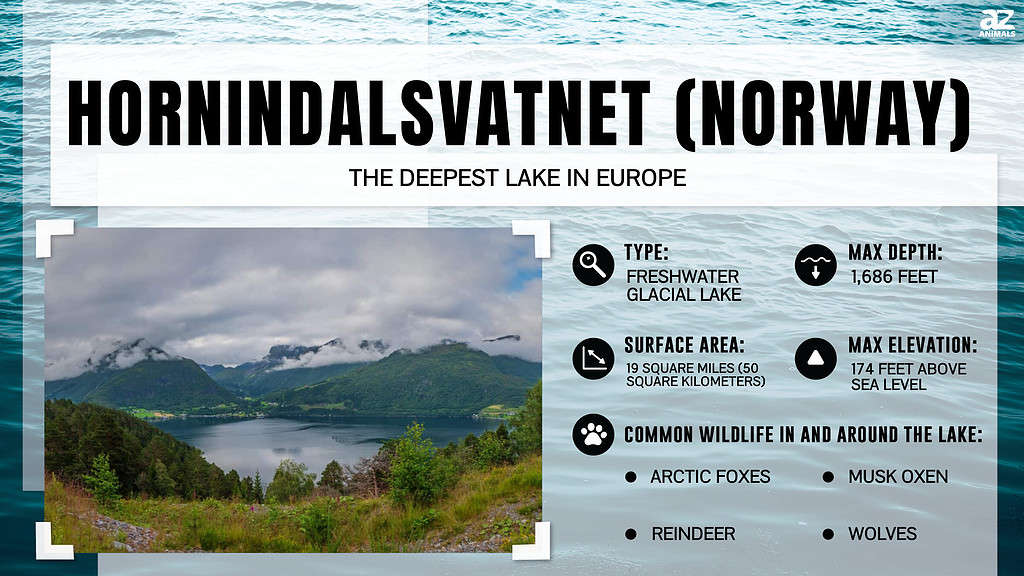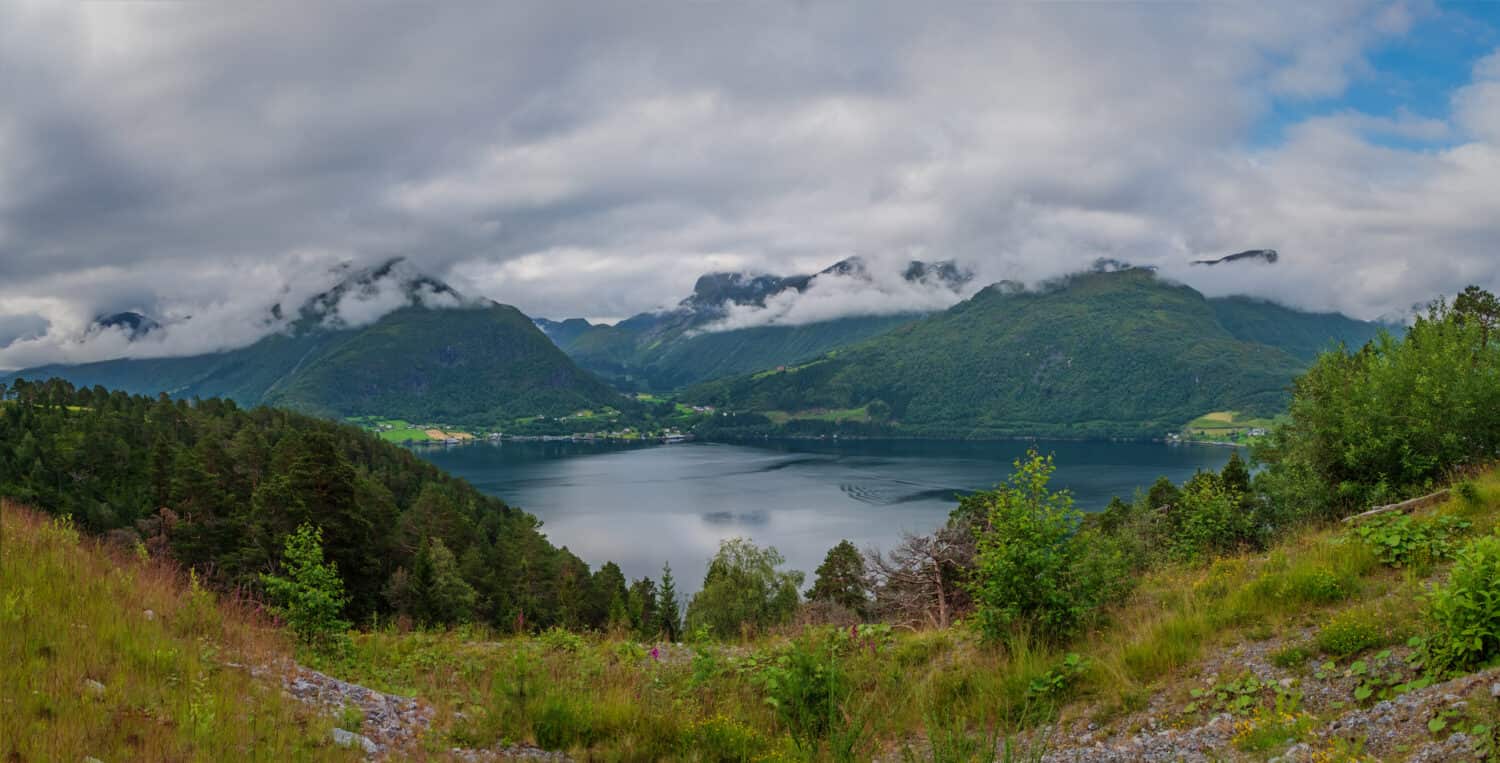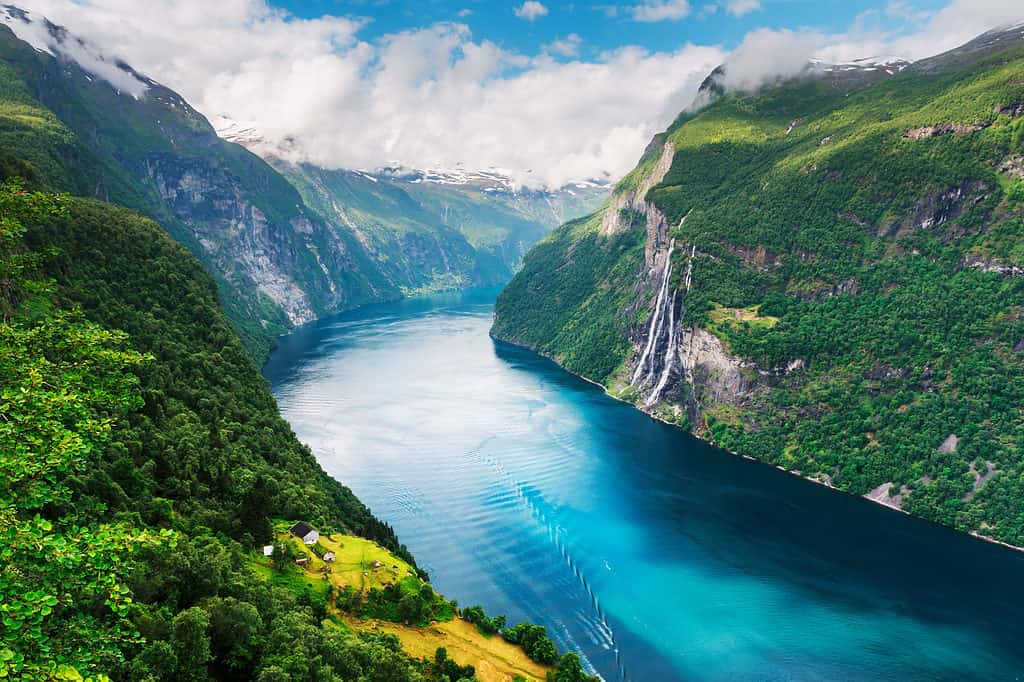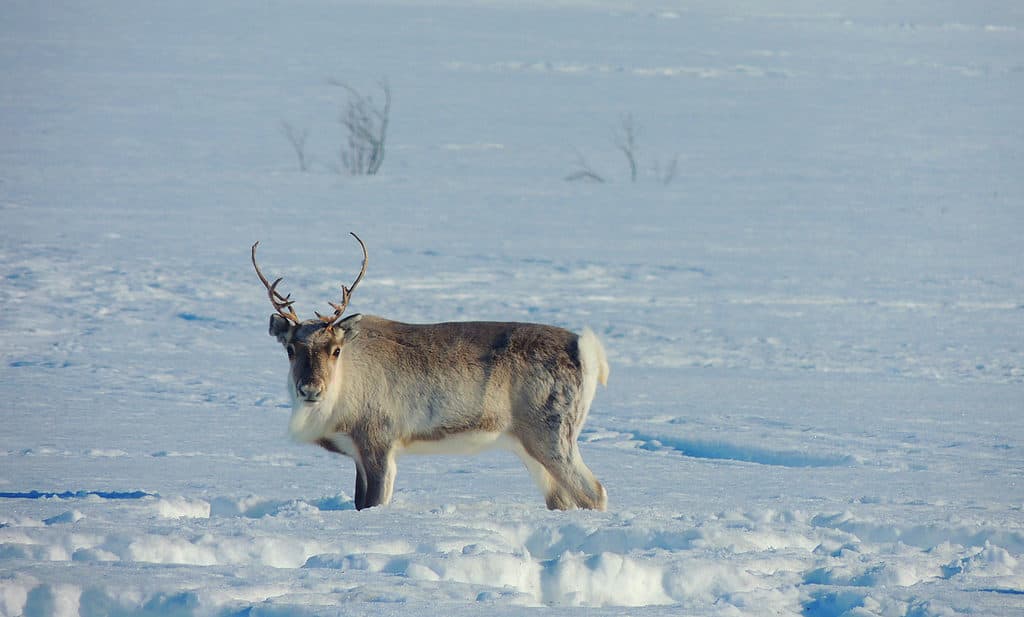Europe has no shortage of incredible lakes. From crystal clear mountain lakes packed with wildlife to man-made hydro-efficient reservoirs, water is all around. The deepest lake in Europe is in northern Europe, in a beautiful country with stunning wild spaces. This article will delve into the deepest lake in Europe, find out how it was created, and what epic wildlife lives nearby.

What Is the Deepest Lake in Europe?
The deepest lake in Europe is Hornindalsvatnet in Norway. It’s a freshwater fjord-like lake whose depth officially measured 1,686 feet (512 meters) in 2006.
Hornindalsvatnet is the 13th deepest lake in the world. An ROV expedition explored its depths in 2006, but some experts believe deeper spots are still awaiting discovery.

Hornindalsvatnet is Europe’s deepest lake at 1,686 feet.
©Sergiy Vovk/Shutterstock.com
Hornindalsvatnet’s Vital Stats
Hornindalsvatnet is 1,686 feet deep, and its volume is around 2.9 cubic miles (12 cubic kilometers). It spreads over 19 square miles (50 square kilometers), and because its surface level is 174 feet above sea level, the lake’s base is 1,512 feet below sea level.
Hornindalsvatnet, the deepest lake in Europe, is in Sogn og Fjordane county within Eid and Hornindal municipalities. On its eastern end lies Grodas village, and Mogrenda village sits on the western side. To the north, Heggiabygda village, with its notable church, is popular with tourists.
Europe’s deepest lake has such clear water the visibility is astonishingly high. It’s clear because no glacier streams run into its water. Instead, its volume is topped up by snowmelt. Of course, this makes the temperature icy cold. The river Eidselva is Hornindalsvatnet’s main outflow. In turn, Eidselva flows in the Eidsfjorden River.
Hornindalsvatnet is sometimes spelled Hornindalsvatet or Hornindalsvatn.
How Was Hornindalsvatnet Lake Formed?
Norway’s deep lakes and fjords formed in the last Ice Age around 10,000 years ago. At this point in time, Norway’s land mass was glazed in a thick 2.5-mile-deep ice sheet. When the ice moved and melted, it scored streams, lakes, and fjords into the land.
Hornindalsvatnet is a fjord-like lake because it’s narrow, deep, and has steep land on either side. However, it has no connection to the sea like most fjords. Ice Age sediments formed a barrier that prevented saltwater expansion from Nordfjord to the west.

Most fjords, like Sunnylvsfjorden fjord, connect to the sea.
©iStock.com/Smitt
The Area Around Lake Hornindalsvatnet
Hornindalsvatnet is a rural lake surrounded by mountains and glaciers, but we’ve seen three villages nestle on its banks. What else is notable here?
Green Sand
One of the most interesting sights around Lake Hornindalsvatnet is the rare green sand along its beautiful shoreline. It’s the only lake in the world with green sandy shores.
The unusual green sand formed due to green mineral deposits from glaciers 10,000 years ago. Only three other locations in the world have green sand:
The olivine (green) sand on these three beaches was caused by volcanic activity.
Tvinnefossen Waterfall
Near Hornindalsvatnet Lake, Tvinnefossen waterfall crashes into an icy pool. This spectacular natural wonder has a pathway behind the cascading freezing water farmers used to move cattle to the shore’s plush greenery. Tourists can still walk behind Tvinnesfossen today.
Where is Europe’s Deepest Lake Located on a Map?
Hornindalsvatnet Lake, Europe’s deepest lake, is located in Norway between the village of Grodas on the eastern end, in the Hornindal Municipality, and Mogrenda on the west, in Eid Municipality. The village of Heggjabygda, which is home to the famous Heggjabygda Church, is situated on the northern shore. The lake is surrounded by mountains, glaciers, and two fjords. Hornindalsvatnet Lake lies next to one of the most famous scenic tourist highways between the cities of Nordfjord and Stryn and is close to the European Route E39.
What Animals Live in Europe’s Deepest Lake?
Europe’s deepest and clearest lake is home to a surprisingly small number of fish. The most interesting is probably a small white fish only discovered when the ROV descended in 2006.
This little fish was observed in the muddy lake bottom, swimming short distances before stopping and submerging its body in the mud.
Norwegian Institute for Nature researchers believe it’s a post-glacially developed type of Arctic char. In Lake Hornindalsvatnet, this fish reaches up to 5.9 inches long. Its head is broad and large with clearly marked eyes. Its two large pectoral fins and tail fin contain soft salmon-like rays. It most likely developed there from eggs that fell into deep lake sections and evolved into a new species.
Other fish in Lake Hornindalsvatnet include trout, char, and eel. Try hiring a boat or simply fish from the green shoreline. However, fishing enthusiasts visiting Norway should try their line in the surrounding rivers rather than Lake Hornindalsvatnet because rivers hold many more fish species, such as salmon.
Either way, a license is required. Just keep your eyes peeled for the legendary sea serpent “Horny”!
Animals Around Lake Hornindalsvatet
The small number of fish species in Europe’s deepest lake is vastly outnumbered by the land animals taking advantage of its clean water and shoreline habitat. Let’s take a look.
Arctic Fox
Arctic foxes live throughout Norway, but most inhabit the northern regions. Their thick white coats provide protection from the harsh conditions. In summer, white fur is replaced with gray for camouflage purposes.
This little fox builds (or inherits) a low mound den called an esker in the arctic tundra and chiefly preys on lemmings, caught using their excellent hearing. An arctic fox’s hearing is so sensitive it can identify a lemming tunneling beneath the snow. Alongside unfortunate lemmings, an arctic fox eats berries, insects, and hares.
They are small foxes, only reaching 11.8 inches tall and weighing just 20.7 lbs, but their fur is the warmest of any mammal. They can withstand temperatures of minus 70!

Arctic foxes chiefly prey on lemmings and arctic hares.
©outdoorsman/Shutterstock.com
Musk Oxen
Herds of musk oxen (sometimes called Muskox) live in the mountainous areas surrounding Lake Hornindalsvatnet. These herbivores eat lichen, grasses, roots, flowers, moss, and arctic willow. These huge oxen weigh 400 – 900 lbs but still reach 37 mph at full pelt.
A thick brown double fur coat fends off the Arctic’s chill. A furry inner coat insulates, and a rough guard coat prevents wind chill and moisture from freezing a musk ox’s skin. In winter, musk oxen use their powerful, sharp hooves to dig out buried tundra plants.
Surprisingly, these large oxen are closer related to goats than cattle! The males’ horns are a goat-like giveaway – they’re connected and form a browband. Locals call it a “boss.”

Musk oxen have a double coat. The outer guard coat repels wind and moisture.
©Fitawoman/Shutterstock.com
Reindeer
30,000 reindeer inhabit Norway’s tundra, where they dine on lichen, ferns, shrubs, grasses, moss, and reindeer moss. Like musk oxen, they live in herds, and thick fur coats protect against the harsh Arctic weather. Reindeer even grow fur on their antlers. Reindeer fur has a special attribute that keeps them toasty in the Arctic. Their fur is hollow, so it traps heated body air and provides an extra insulation layer.
Another epic adaptation is their ability to see ultraviolet light. It is the only mammal experts think to have this skill. Being able to use ultraviolet light helps them spot white-furred predators in a snowy landscape, predators like the formidable polar bear.

Reindeer hair is hollow, so it can trap warm air and retain body heat efficiently.
©MJShepherd/Shutterstock.com
Wolves
Native yet critically endangered Norwegian wolves live in packs of up to 15 and inhabit Norway’s forests and mountains. Males weigh 87-147 lbs and stand 33 inches at the shoulder. Despite maintaining the right types of ecosystems, Norway is home to very few wolves. The majority live in wolf zones where hunting is restricted except from January to February 15th. Outside the wolf zone, hunting is legal from December to May.
Their chief prey is hare and moose, but they will eat carrion too. These wolves avoid human contact, and even though they’re blamed for sheep and cattle deaths, they rarely take domesticated animals.

Eurasian wolves in Norway chiefly eat hare and moose.
©Alan Jeffery/Shutterstock.com
Moose
Also known as elk, this European deer species is one of Norway’s favorite burger ingredients. Common in Norway, elk-watching safaris are a fun way to experience Norway’s wild spaces safely.
The largest moose can reach 1500 lbs in weight and reach six feet at the shoulder but still manage to run at 35 mph! Males grow huge comb-shaped antlers which they shed annually.
Herbivorous moose eat grass, moss, flowers, lichens, and aquatic plants. In harsh conditions, their hooves act like snow shoes so they can cover vast distances to search out plant life.
Biggest Lake in Europe
Lake Hornindalsvatnet is the deepest lake in Europe, but what’s the biggest lake in Europe?
That honor goes to Lake Lagoda in St. Petersburg, Russia. Its surface size is 6,800 square miles (17,700 km). It’s so huge that 660 islands with abundant wildlife are spread across its waters.
Europe’s Deepest Lake: Re-cap
Europe’s deepest lake is 1,686 feet deep, Lake Hornindalsvatnet, a freshwater fjord-shaped lake in Norway. Ice Age glaciers carved it out 10,000 years ago, and it’s the only lake in the world with green sand due to its mineral deposits.
The photo featured at the top of this post is © Sergiy Vovk/Shutterstock.com
Thank you for reading! Have some feedback for us? Contact the AZ Animals editorial team.






